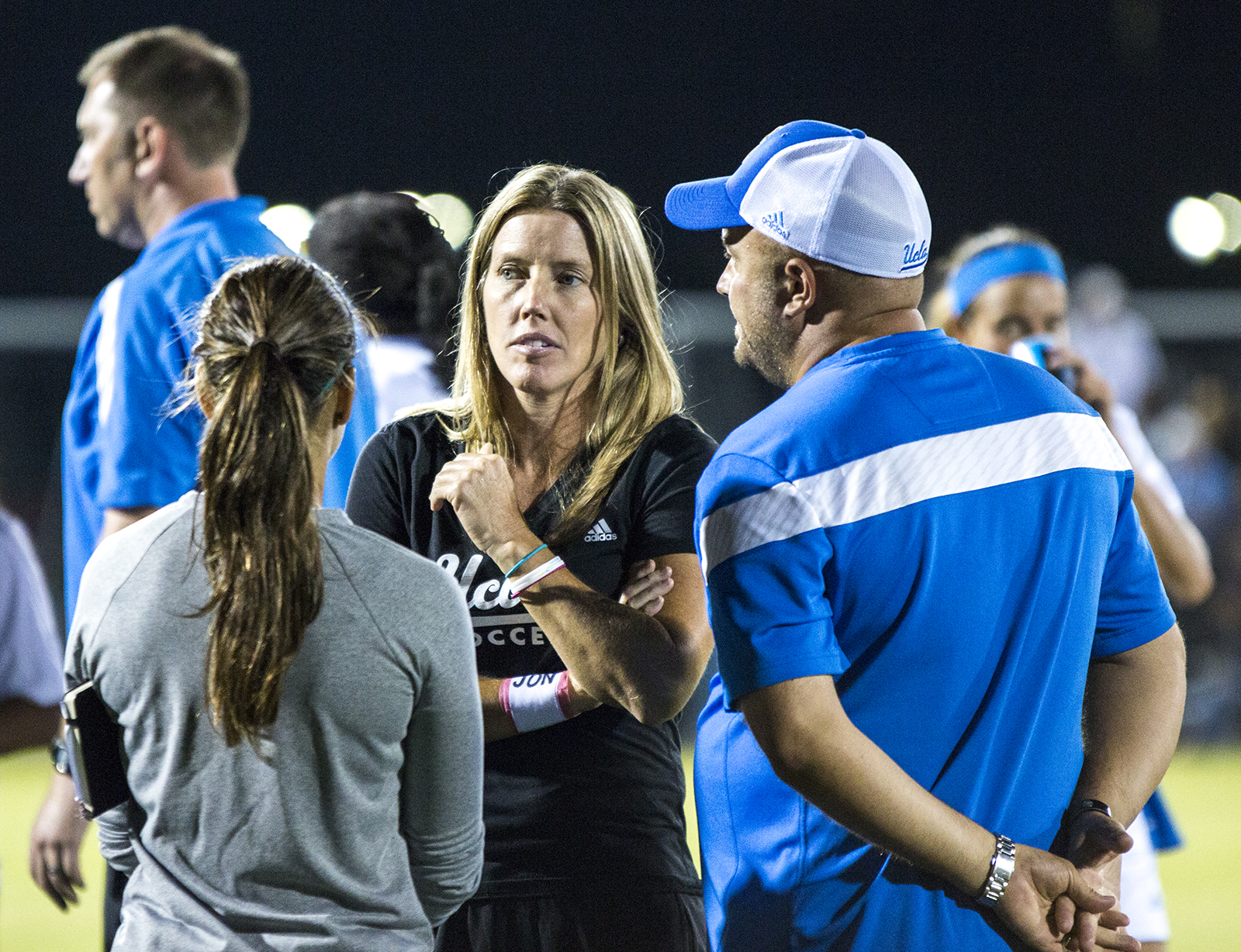Versatility of offense keeps UCLA women’s soccer at No. 1

Throughout No. 1 UCLA women’s soccer’s undefeated season, coach Amanda Cromwell (center) and her coaching staff have implemented several different tactical setups that have helped the team overcome some of the tougher defenses it has faced in the season. (Aubrey Yeo/Daily Bruin senior staff)
By Aubrey Yeo
Oct. 8, 2014 2:17 a.m.
No matter how good a team’s defense may be, the reality of sports is if you can’t score, you can’t win.
Sometimes, simply finding ways to score is a task easier said than done – especially in games where the opponents decide to make stopping the offense a priority.
It’s games like these where the art of coaching takes over.
“We have to figure out – when there are numbers behind the ball and they’re defending well – how to break them down,” said UCLA coach Amanda Cromwell.
On Sunday, when Colorado’s defense became too tough of a lock to pick in the first half, Cromwell turned to a formation switch as the key.
About 20 minutes into the first half, No. 1 UCLA switched from its regular 4-2-3-1 formation to a more offense-heavy 3-5-2.
“I think the coaches wanted to see something different,” said sophomore midfielder Lauren Kaskie. “It was working, so we just kept with it and progressed with it in the second half.”
Now with more personnel to fill roles on offense, redshirt freshman defender Zoey Goralski was able to cross a low ball to an unmarked Sam Mewis in the box. The senior midfielder latched onto the delivery to score the game-winner.
Sunday’s 1-0 win wasn’t the first time the Bruins unleashed this formation, however, having done so in several times of need. Perhaps the most memorable one was when the team, desperate for a goal after trailing Virginia 0-1 in the NCAA tournament semifinals, found one from then-junior defender Ally Courtnall, who switched to right wing back.
But even when the Bruins are operating in their typical 4-2-3-1, they’ve been able to modify their tactics around their opponents’ defensive systems.
When faced with San Diego’s heavy man-marking earlier in the season, Cromwell took a page out of basketball and used a pick-and-roll analogy to explain the key to overcoming the man-to-man defense.
“We were talking about setting up one vs. one’s and two vs. two’s and just getting out of the way,” Cromwell said after the game against USD. “Almost like when you clear out for somebody to go one vs. one – it’s the same kind of concept.”
During Friday’s matchup with a Colorado team keen on keeping a clean sheet, the Bruins exerted extra pressure on a Buffalo defense intent on slowing the tempo of the game in order to force out an error.
“Against different teams, we’ll have different strategies pressing as they come out of the back,” Mewis said. “(Colorado) did something different that we haven’t really seen yet this year. … I think we did a better job in the second half of figuring out our pressure system.”
The Bruins’ wealth of options from their playbook call for different positions to be filled and could pose the potential problem of needing the right players to execute those plans. But the team has found its answer in two different ways.
A total of 23 players have shared minutes over the course of the 12-game season thus far. That deep roster makes finding the right person for each situation a much simpler task.
And in some cases, certain individuals on the team have shown the ability to plug in their skills at different locations in accordance with whatever needs the coaches may see.
Sunday’s game saw sophomore Annie Alvarado – a player who has spent most of her game minutes this season operating as a defensive midfielder – start the game at left forward instead.
In that same game, senior Megan Oyster was featured in three different positions – center back, left back and right back – depending on the formation that the Bruins were utilizing.
Throughout her two seasons at UCLA, sophomore Gabbi Miranda has been able to fill roles at center back, left back, left forward and defensive midfielder. But what really solidifies her role as an impact player coming off the bench is her ability to literally add a new spin on the ball as a naturally left-footed player – an attribute that was key in UCLA’s clincher of the Pac-12 championship last year against Oregon.
It’s hard to pinpoint whether it’s the team’s tactical setups, roster depth, individual player versatility or even one giant mash-up of all three that has kept UCLA as the top-ranked team all season. But they’re all things UCLA’s opponents will have to factor into their game plan.


